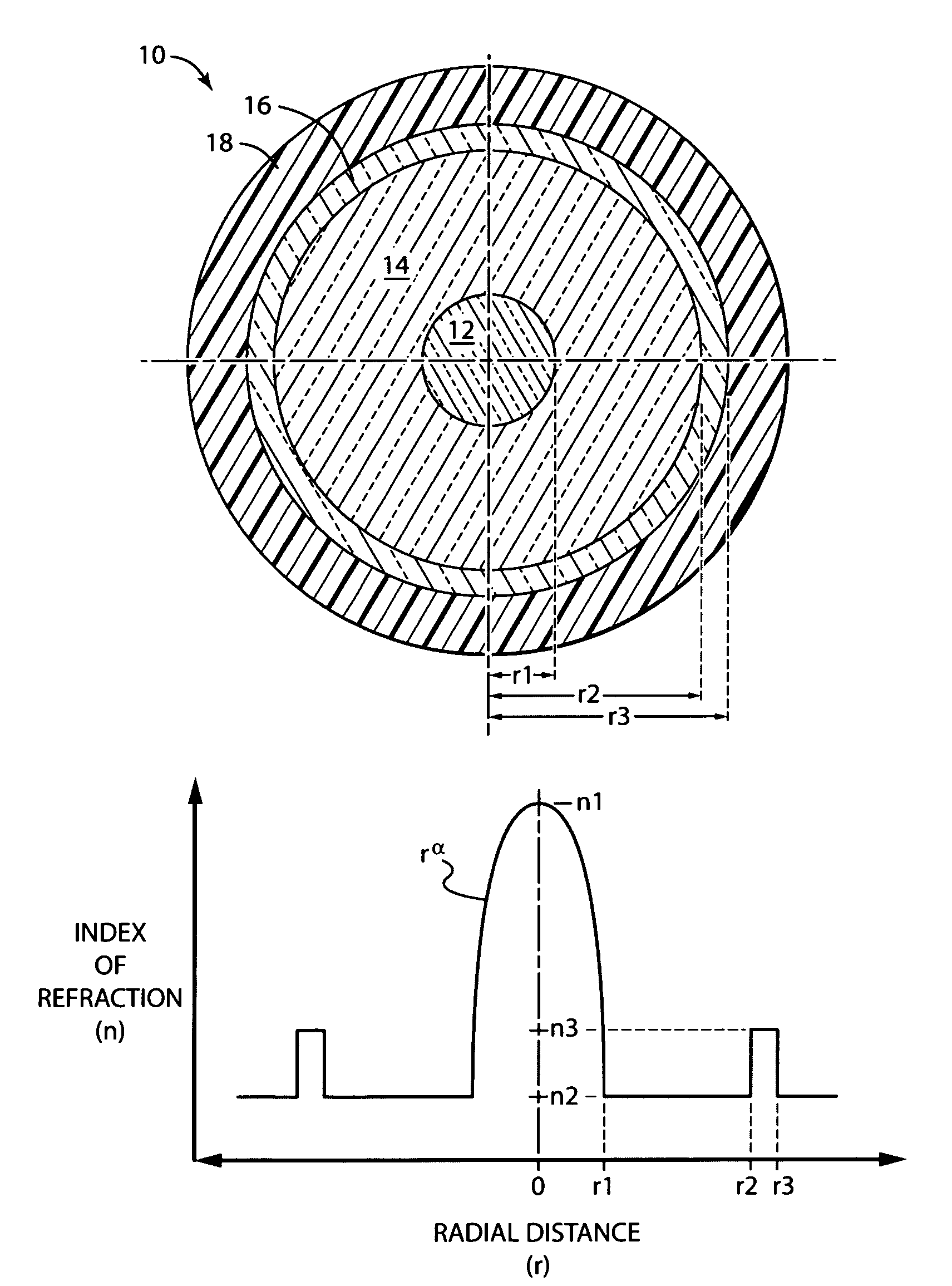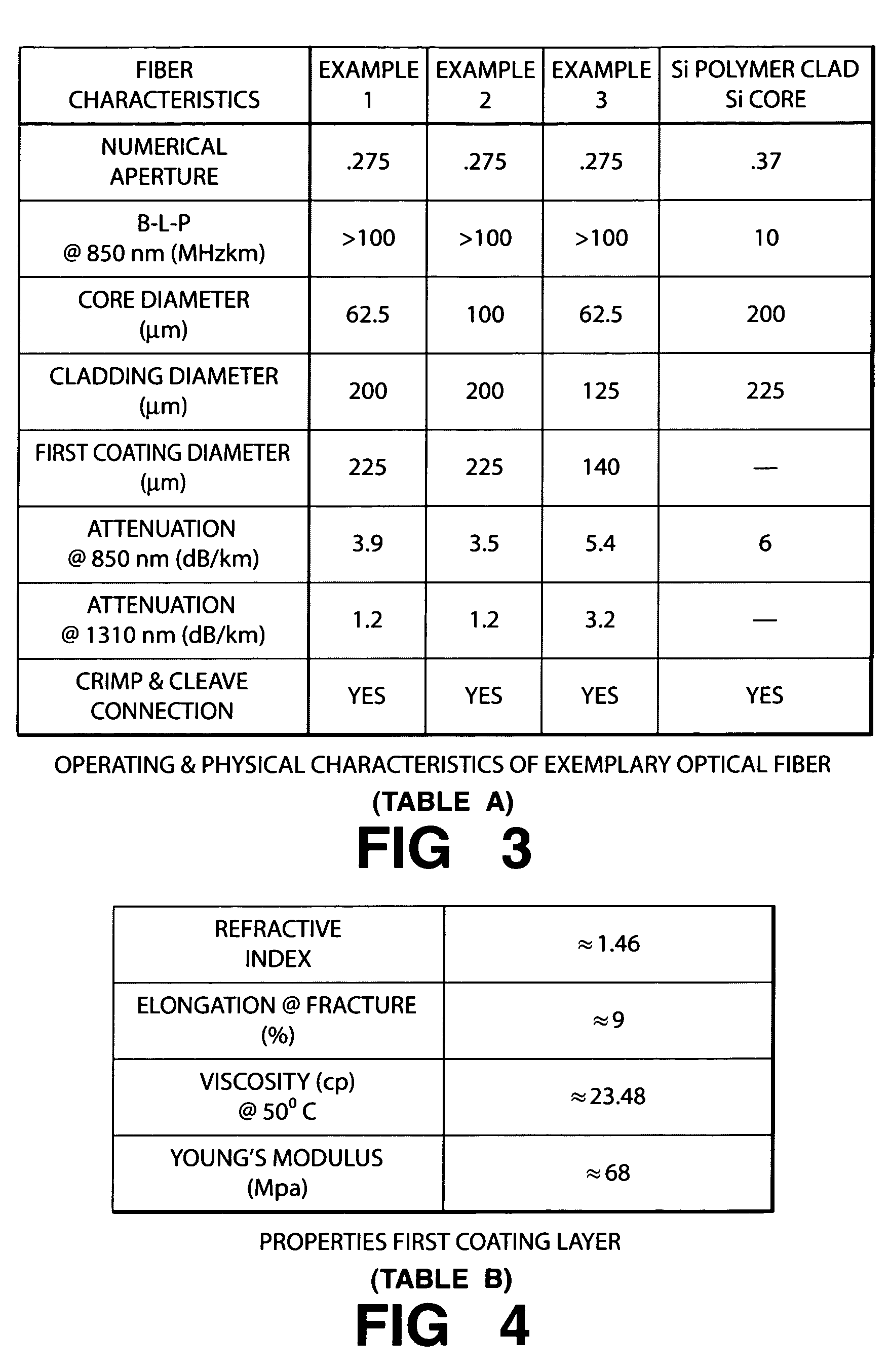Optical fiber with extended bandwidth for crimp and cleave connectors
a technology of optical fiber and connector, which is applied in the direction of glass optical fiber, cladded optical fibre, instruments, etc., can solve the problems of difficult to use such optical fiber in newer applications, high speed or longer fiber link lengths, and reduce the service life of optical fiber, so as to increase the bandwidth-length product of optical fiber, the effect of high bandwidth connectorization
- Summary
- Abstract
- Description
- Claims
- Application Information
AI Technical Summary
Benefits of technology
Problems solved by technology
Method used
Image
Examples
example 1
[0026]A preform manufactured by an MCVD process to provide a Ge doped core and a non-doped silica cladding. The optical profile of the preform is such that, when it is drawn, the optical fiber produced will have a core diameter of 62.5 μm and a clad diameter of 200 μm. The refractive index of the core is a graded profile and varies as a power function of the radial distance from the center of the fiber, Rα, where α=˜2. The refractive index of the cladding is approximately that of silica. The preform was then set on a draw tower with one end in a furnace. When the draw or drip end of the preform became molten it was tensioned and optical fiber was drawn from it. During drawing, the optical fiber is first coated with a UV curable polymer formulated according to Skutnik, et al. to have the properties of set forth in Table B of FIG. 4 by the application of a uniform and thin layer of liquid polymer via a coating die. The first coating was applied to a thickness of ˜12 μm. and has a refr...
example 2
[0028]A preform manufactured by an MCVD process to provide a Ge doped core and a non-doped silica cladding. The optical profile of the preform is such that, when it is drawn, the optical fiber produced will have a core diameter of 100 μm and a clad diameter of 200 μm. The refractive index of the core is a graded profile and varies as a power function of the radial distance from the center of the fiber, Rα, where α=˜2. The refractive index of the cladding is approximately that of silica. The preform was then set on a draw tower with one end in a furnace. When the draw or drip end of the preform became molten it was tensioned and optical fiber was drawn from it. During drawing, the optical fiber is first coated with a UV curable polymer formulated according to Skutnik, et al. to have the properties of set forth in Table B of FIG. 4 by the application of a uniform and thin layer of liquid polymer via a coating die. The first coating was applied to a thickness of ˜12 μm. and has a refra...
example 3
[0030]A preform manufactured by an MCVD process to provide a Ge doped core and a non-doped silica cladding. The optical profile of the preform is such that, when it is drawn, the optical fiber produced will have a core diameter of 62.5 μm and a clad diameter of 125 μm. The refractive index of the core is a graded profile and varies as a power function of the radial distance from the center of the fiber, Rα, where α=˜2. The refractive index of the cladding is approximately that of silica. The preform was then set on a draw tower with one end in a furnace. When the draw or drip end of the preform became molten it was tensioned and optical fiber was drawn from it. During drawing, the optical fiber is first coated with a UV curable polymer formulated according to Skutnik, et al. to have the properties of set forth in Table B of FIG. 4 by the application of a uniform and thin layer of liquid polymer via a coating die. The first coating was applied to a thickness of ˜12 μm. and has a refr...
PUM
| Property | Measurement | Unit |
|---|---|---|
| diameter | aaaaa | aaaaa |
| diameter | aaaaa | aaaaa |
| refractive index | aaaaa | aaaaa |
Abstract
Description
Claims
Application Information
 Login to View More
Login to View More - R&D
- Intellectual Property
- Life Sciences
- Materials
- Tech Scout
- Unparalleled Data Quality
- Higher Quality Content
- 60% Fewer Hallucinations
Browse by: Latest US Patents, China's latest patents, Technical Efficacy Thesaurus, Application Domain, Technology Topic, Popular Technical Reports.
© 2025 PatSnap. All rights reserved.Legal|Privacy policy|Modern Slavery Act Transparency Statement|Sitemap|About US| Contact US: help@patsnap.com



